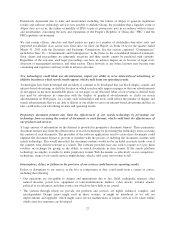Yahoo 2011 Annual Report Download - page 26
Download and view the complete annual report
Please find page 26 of the 2011 Yahoo annual report below. You can navigate through the pages in the report by either clicking on the pages listed below, or by using the keyword search tool below to find specific information within the annual report.technical expertise. As we acquire users who rely upon us for a wide variety of services, it becomes more
technologically complex and costly to retrieve, store, and integrate data that will enable us to track each user’s
preferences. Any difficulties experienced in adapting our architectures, platforms and infrastructure to
accommodate increased traffic, to store user data, and track user preferences, together with the associated costs
and potential loss of traffic, could harm our operating results, cash flows from operations, and financial
condition.
We have dedicated considerable resources to provide a variety of premium products and services, which might
not prove to be successful in generating significant revenue for us.
We offer fee-based enhancements for many of our free services. The development cycles for these technologies
are long and generally require significant investment by us. We have invested and will continue to invest in
premium products and services. Some of these premium products and services might not generate anticipated
revenue or might not meet anticipated user adoption rates. We have previously discontinued some non-profitable
premium services and may discontinue others. General economic conditions as well as the rapidly evolving
competitive landscape may affect users’ willingness to pay for such premium services. If we cannot generate
revenue from our premium services that are greater than the cost of providing such services, our operating results
could be harmed.
We rely on third parties to provide the technologies necessary to deliver content, advertising, and services to
our users, and any change in the licensing terms, costs, availability, or acceptance of these formats and
technologies could adversely affect our business.
We rely on third parties to provide the technology to deliver content, advertising, and services to our users. There
can be no assurance that these providers will continue to license their technologies to us on reasonable terms, or
at all. Providers of those technologies may change the fees they charge users or otherwise change their business
model in a manner that slows the widespread acceptance of their technologies. In order for our services to be
successful, there must be a large base of users of the technologies necessary to deliver our content, advertising,
and services. We have limited or no control over the availability or acceptance of those technologies, and any
change in the licensing terms, costs, availability, or user acceptance of these technologies could adversely affect
our business.
If we are unable to attract, sustain, and renew distribution arrangements on favorable terms, our revenue may
decline.
We enter into distribution arrangements with third parties such as operators of third-party Websites, online
networks, software companies, electronics companies, computer manufacturers, and others to promote or supply
our services to their users. For example:
• We maintain search and display advertising relationships with Affiliate sites, which integrate our advertising
offerings into their Websites.
• We enter into distribution alliances with Internet service providers (including providers of cable and
broadband Internet access) and software distributors to promote our services to their users.
• We enter into agreements with mobile, tablet, netbook, television, and other device manufacturers, electronics
companies and carriers to promote our software and services on their devices.
In some markets, we depend on a limited number of distribution arrangements for a significant percentage of our
user activity. A failure by our distributors to attract or retain their user bases would negatively impact our user
activity and, in turn, would reduce our revenue. In some cases, device manufacturers may be unwilling to pay
Yahoo! fees in order to distribute Yahoo! services.
24
























